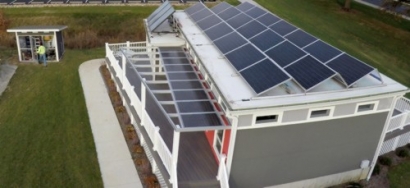
Members of Missouri S&T’s Microgrid Industrial Consortium will use the microgrids to test advancements in lead battery energy storage for their potential use as a renewable energy source in communities of the future. Two homes occupied by students will be individually supplied with stored electricity from the systems, which run off charging algorithms from a 24-hour, cloud-based control system.
The Missouri S&T Microgrid Industrial Consortium is a collaborative research alliance that includes the Advanced Lead Acid Battery Consortium (ALABC), a research group and program of the International Lead Association (ILA); The Doe Run Co., a Missouri lead mining and battery recycling company; Ameren, Missouri’s largest energy utility provider; the Missouri Public Utility Alliance (MPUA); the Missouri Department of Economic Development Division of Energy (MO DED); and Missouri S&T’s Center for Research in Energy and Environment (CREE).
ALABC members NorthStar Battery and EnerSys, both global battery manufacturers, and The Doe Run Co. donated the equipment and funding to construct the new microgrids.
Lead batteries are typically known as a tried-and-true rechargeable energy source. According to the ILA, up to 90 percent of modern lead usage is in the production of batteries. The ILA further states that more lead is produced by recycling than is mined, making it ideal for a circular economy. According to the 2017 National Recycling Rate Study commissioned by Battery Council International (BCI), lead batteries are the most recycled consumer product in the U.S. with a 99.3 percent recycling rate.
Missouri-based microgrid consortium partner Doe Run manages nearly the full lifecycle of lead. “From mining underground deposits, to supplying Missouri battery manufacturers with lead and lead alloys, to reclaiming and recycling lead from spent batteries, Doe Run provides more than a $1 billion a year in economic value to Missouri,” said Chris Neaville, the company’s asset development director and a 1987 geological engineering graduate of Missouri S&T.
Dr. Mehdi Ferdowsi, director of Missouri S&T’s Microgrid Industrial Consortium and a professor of electrical engineering and computing, emphasized that the new microgrid systems will allow researchers to explore the application of advanced lead batteries in stationary grid-tied applications, as most similar research to date has been with lithium batteries. “We’ll also be able to conduct research on potential peer-to-peer energy transactions that could result from this use — that is, the energy trading between consumers and ‘prosumers,’ those who both produce and consume the energy,” Ferdowsi added.
The EcoVillage homes were designed by S&T students who competed in the U.S. Department of Energy’s Solar Decathlon, and they draw about 1,000 visitors a year. The two homes powered by the advanced lead microgrids will run alongside four other solar homes exploring alternative technologies. The EcoVillage is the second grouping of student-designed solar homes. Missouri S&T’s first four entries in the Solar Decathlon constitute the Solar Village, located on 10th Street and Poole Avenue, across from the Gale Bullman Building.
The project has a three-year timeline for research and study, and should be completed by 2021.

